Bombs and Bombs - Hamilton Airshow
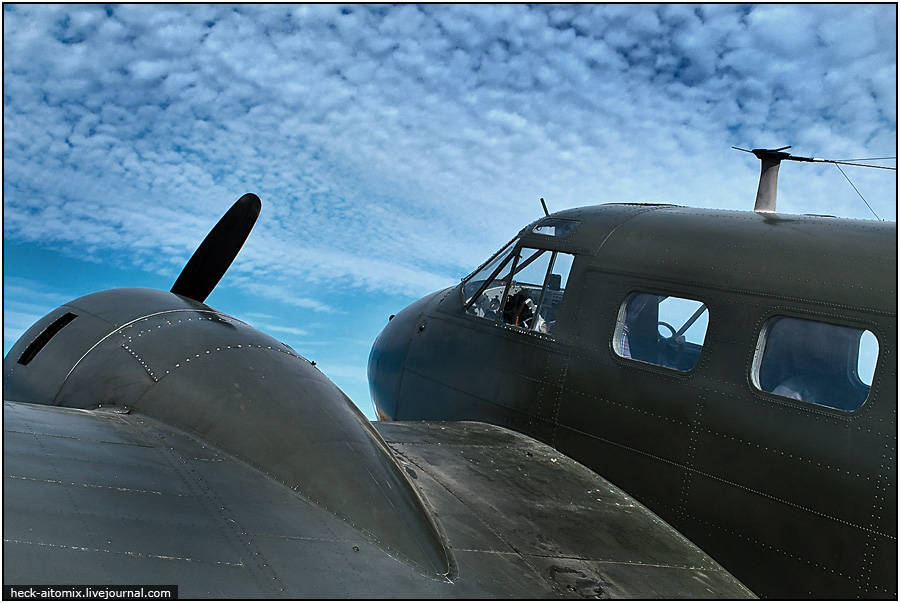
One of the first indicative and intimidating operations involving heavy bombers was carried out by the Spanish general Franco during the Spanish Civil War. Thanks to good relations with the fascist regimes in Germany and Italy, Franco was able to enlist the support of German (Junkers) and Italian (Pipistrello) aircraft for carpet bombing of Republican forces and civilian objects.
At the beginning of World War II, the Luftwaffe consisted of an impressive number of bombers that were actively used in the strategy of Hitler's “blitzkrieg”, who launched air strikes and supported the advance of ground forces. With the total superiority of the Germans in the air, it seemed that nothing would prevent them from winning this war ...
We, once the inhabitants of the 1 / 6 part of the land, World War II is most well known during the period of the Great Patriotic War - one of the most brutal and extensive fronts of military operations. Without diminishing the dignity of the defenders of the Soviet fatherland, I want to note that before the Second World War and outside the USSR the war was no less cruel and no less terrible. Living now in Canada - the dominion of the British Commonwealth, you will learn a lot of new things about that side of the war, which was not very thoroughly covered in Soviet textbooks stories. In particular, few people know about one of the largest air battles - the “Battle of Britain”, which lasted from July to November of the year 1940. It is this protracted military campaign in which the Third Reich suffered its first defeat in World War II, which is considered one of the turning points of that war.
During the Battle of Britain, mainly middle-class twin-engine bombers were used, carrying tons of bomb stocks in the 1,5-2. Having repulsed the German attacks, the British realized that this class of aircraft would not be enough to wage a full-scale war with Hitler, but they were ready. Since the middle of the 30s in Britain, heavy four-engine strategic bombers have been developed, capable of carrying up to 6 tons of bombs! They were represented by Short Stirling and Handley-Page Halifax (the first British heavy bombers) were able to unpleasantly surprise the German command in 41. But these planes were only flowers, the berry ripened a bit later - in 1942, the most successful English (and not generally) World War II Avro Lancaster bomber flew out to fight the Germans!
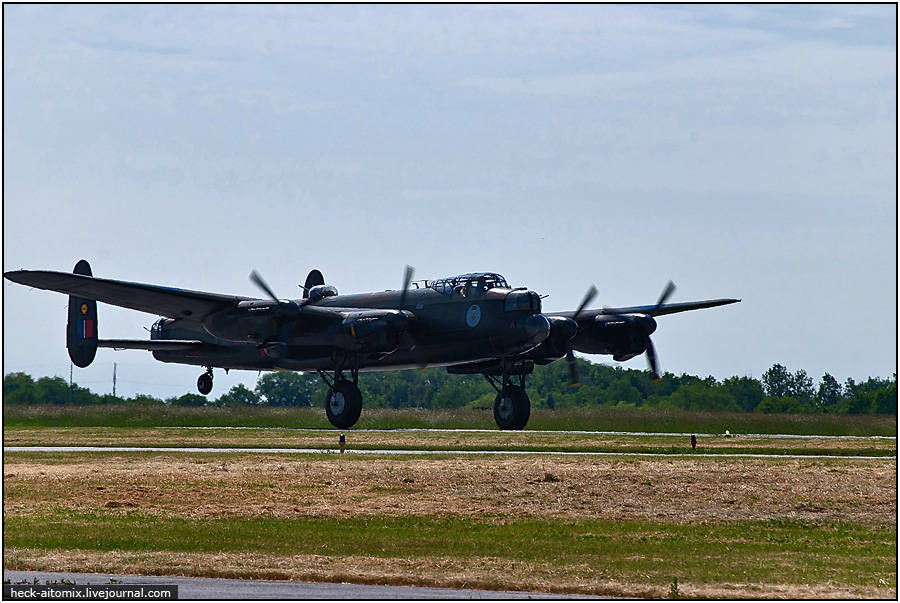
This unique aircraft possessed unsurpassed flying characteristics - it was able to climb 8 km altitude and bring its bomb stock to a distance of 4300 km. Armed with this giant was the eight of the 7,7-mm machine guns (two in the nose, two in the dorsal, four in the tail turret). A bomber stuffed with machine guns was reasonably well protected and did not require escort fighters. Actually, since at that time there were no such fighters who could accompany this giant during his long-range raids, he had to defend himself ... Well, in the bomb reserve he had no equal in the world for quite a long time - Lancaster was able to raise 6,5 tons of bombs in the air or one, but sooooo big bomb weighing 9979 kg (Grand Slam)!
During the 1942-1945 period, all of the British Lancaster put together made more than 156 thousands of sorties and dropped almost 620 thousand tons of bombs, bombs, and bombardments.
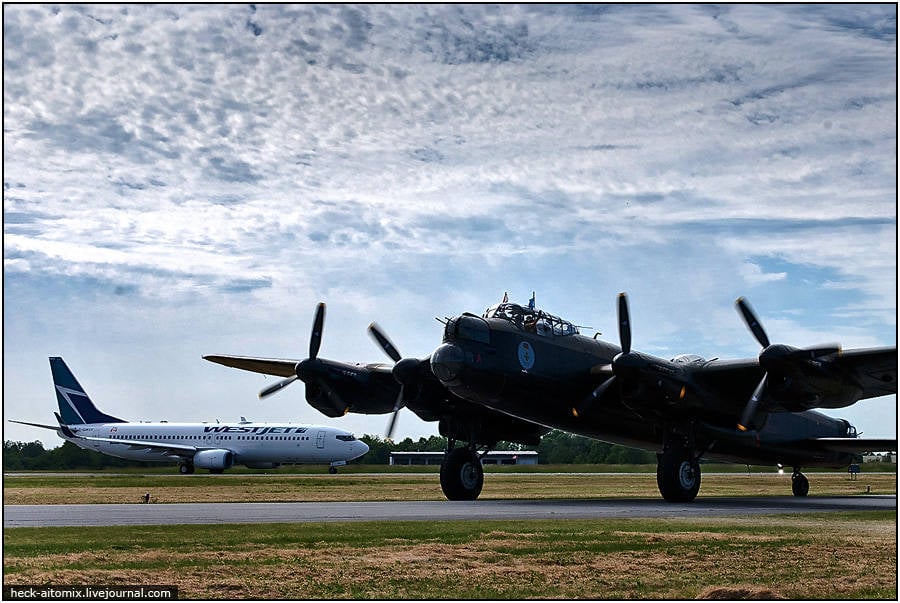
Avro Lancaster became the highlight and the main character in the Hamilton Air Show. Around the world at the moment there are only 2 copies of this aviation legend capable of rising into the air. One is in the English Museum of the Battle of Britain, and the other is in the possession of the Canadian Museum of the Canadian Military Aviation Heritage. The specimen on display came off the factory assembly line in 1945, and served as a naval patrol bomber until it retired in 1964. After wandering through several museums, he underwent a course of full restoration and restoration at the beginning of the 80s of the last century, and was able to take to the sky again in 1988.
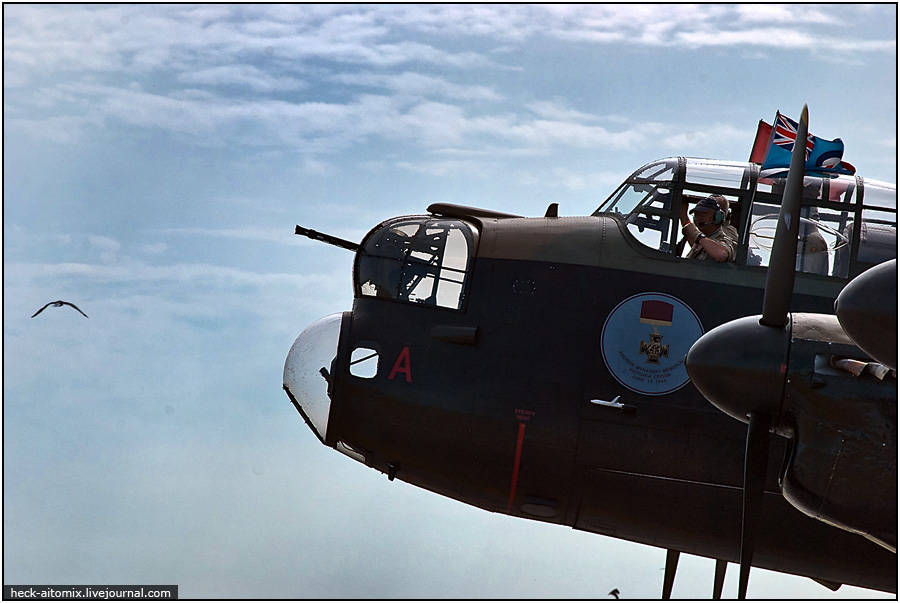
Coloring and identification marks of this Lancaster (VR-A, KB726) are made in memory of another outstanding Canadian soldier (son of a Polish immigrant) during World War II - Andrew Minarski. In 1944, he was in the service of the Royal Canadian Air Force as an air gunner in the 419 squadron. On June 5, the day before the Allied troops landed in Normandy, the crew of Minarski was transplanted to the newly built (by the way, one of the Canadian aircraft factories) and Lancaster with the hull number KB726 smelling of paint. A week later, on June 12, the crew received a combat mission: the target was one of the railway depots on the territory of Cambrai in France. It was the 13-th departure of the crew. Departure was the night of 12-th on 13-th June. 13 was friday. I don’t know if the Lancaster team really thought about these coincidences, or it’s already historians that have dramatized the situation, but the fact remains: the 13 th departure on 13 on Friday ... Andy found a four-petal clover, which he handed to his best friend Pat Brophy - arrow tail turret.
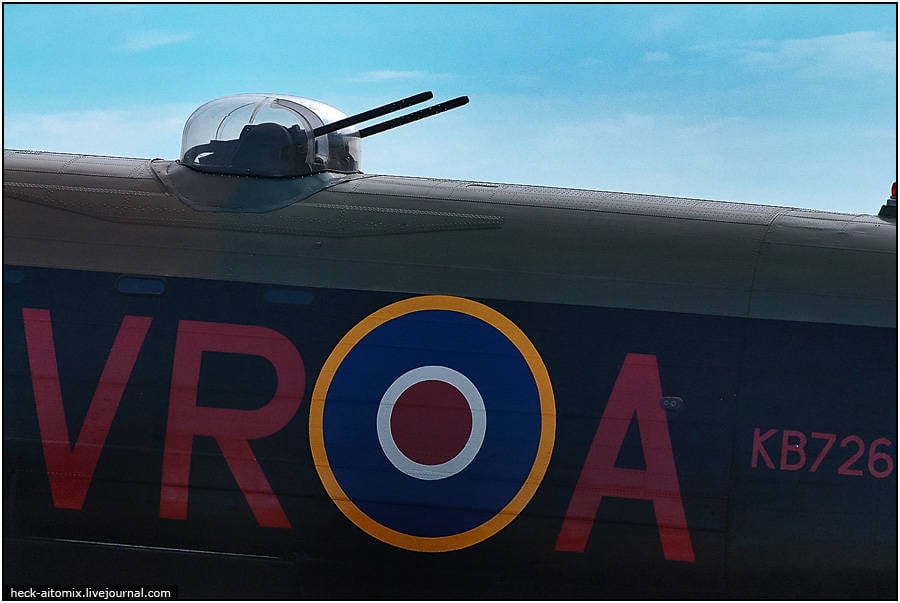
... Approaching the French sites, Lancaster was discovered by the German air defense system, and some time later attacked by Junkers-88. The German ace managed to damage two engines, and also broke the hydraulic lines in the tail section of the aircraft. The captain of the crew gave the order to leave the blazing car. Andy Minarski, who was in charge of the upper turret in the middle of the fuselage, left his place and was ready to evacuate, but through the fire wall in the tail section he saw that Pat Brophy could not get out of his shooting place - the damaged power lines did not allow him to turn the turret to the exit position. In desperate attempts to turn the turret with the help of a manual drive, Pat damaged the mechanism and was now stuck in a shooting capsule in a tail-ridden fire. Andrew began to break through the flames to help a friend to help a friend defeat the locked turret mechanism. After vain attempts to turn the capsule, Andy saw that Pat had stopped his struggle and insistently pointed to the door, demanding that Andy be evacuated. Minarski had no choice but to return through the fire to the emergency exit. Before landing, he turned towards the doomed comrade, saluted him, although the jumpsuit and the parachute satchel were already burning, and only after that left the falling bomber ...
When the Allied troops found Andy Minarsky who had landed, he was burned so much that he could neither move nor speak. A few hours later he died from extensive burns. Ironically, Pat Brophy managed to survive. By some miracle, he did not die either when the bomber fell, or when two of the existing 20 bombs detonated, from which his capsule, together with him, was thrown a few hundred meters from the blasted plane by the explosion itself. Pat survived and told about Andy's desperate attempt that cost life. Posthumously Andy Minarsky was awarded the highest award of the British Commonwealth - Victoria Cross ... Andy Charles Minarsky's watch stopped at 02: 13 on Friday 13 of June 1944 of the year.
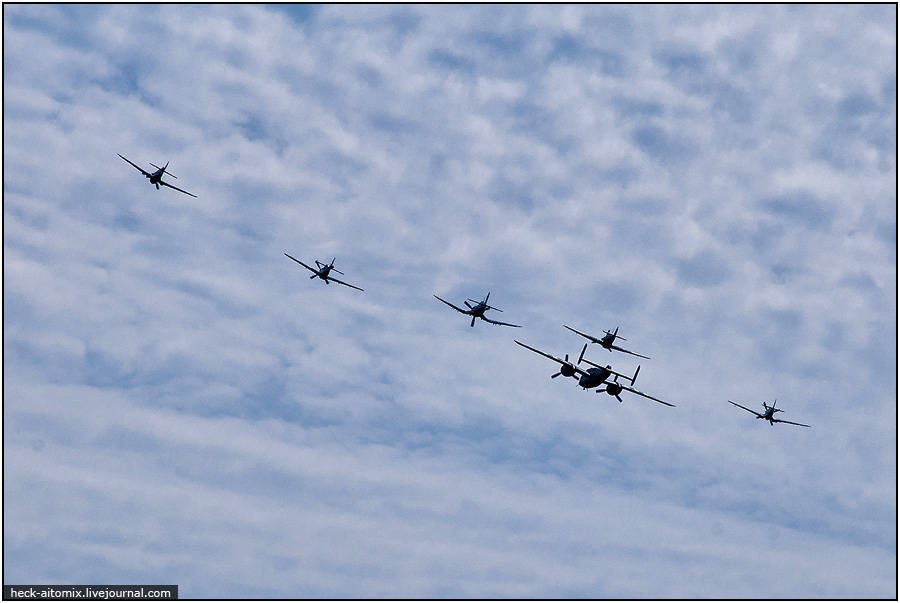
... The low booming roar of 4 engines Lancaster caressed the audience’s ears not alone - the bomber soared into the sky, made several visits over the airfield, after which the fighter part of the program joined it - Spitfire, Hurricane, Mustang, Corsair, Firefly. Of course, during the war these planes didn’t fly and couldn’t fly, but it was this way, with such a bunch, warmly shaking their wings, they paid tribute to those who fought on these machines.
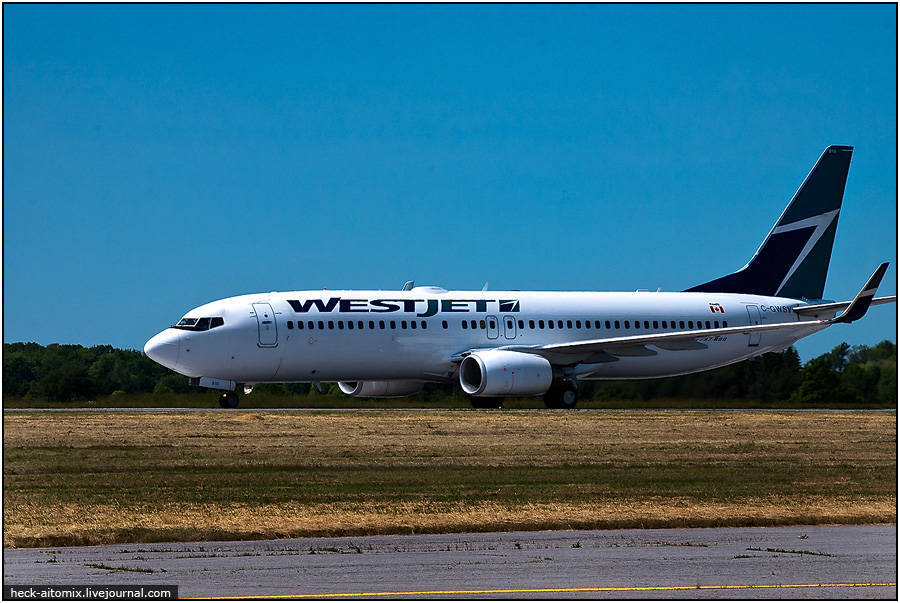
On the day of the airshow, the Hamiltonian airport worked in its usual way, receiving and sending scheduled airplanes as scheduled. At the same time, dispatchers put one of the passenger flights right in the pause between the demonstration flights to the runway closest to the audience. WestJet's flight from Saskatun was greeted with applause from the audience, and the organizers of the air show also used the crew of the passenger Boeing in the local lottery. Immediately after landing, the captain of the arriving crew was launched via radio to the speakers on the airfield, and he directly from the steering track directly congratulated all the spectators on the aviation holiday, and also read out the names of the winners of the local lottery organized by the Museum during the airshow.
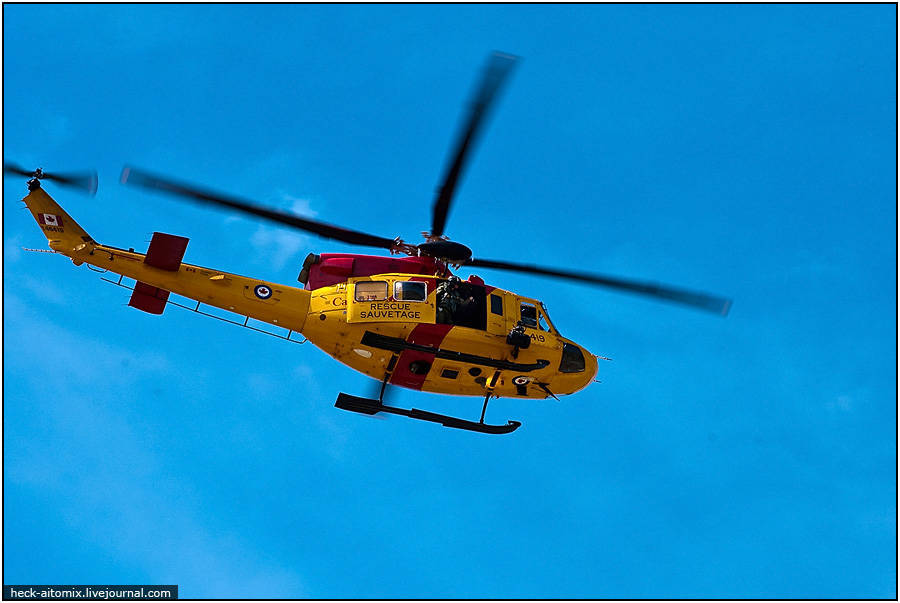
A couple of minutes later, the announcer announced that the organizers were forced to make a short pause in the show, since the rescue service of the Hamiltonian district based on the same airfield received an urgent call. Immediately, helicopters of the local Emergencies Ministry flew into the air, greeted numerous spectators and set off to save someone from something.
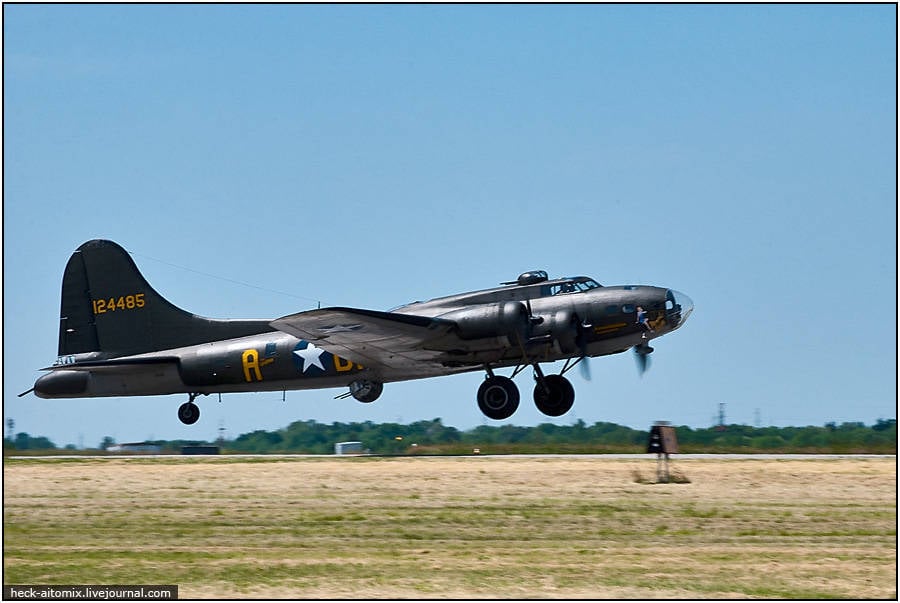
After this forced break, the show continued. The time has come for the real Flying Fortresses. Two Boeing B-17 Flying Fortresses rose to the sky. American four-engine heavy bombers got their name not by chance - they were really designed in such a way as to constitute an impregnable fortress. First, nine, and later - thirteen12,7-mm machine guns provided them with sufficient protection. He could reach speeds of up to 500 km / h and go up to heights of 11 km. The unique design made this aircraft a legend - the car withstood heavy damage, there are cases when the B-17 returned to the base on just one of its four engines. Another unique feature of this bomber was the bomb guidance system, which allowed attacking targets from a height of 7 km, so the small bomb reserve (up to 3 tons) that the Flying Fortress could carry was fully justified - all the bombs went right on target.
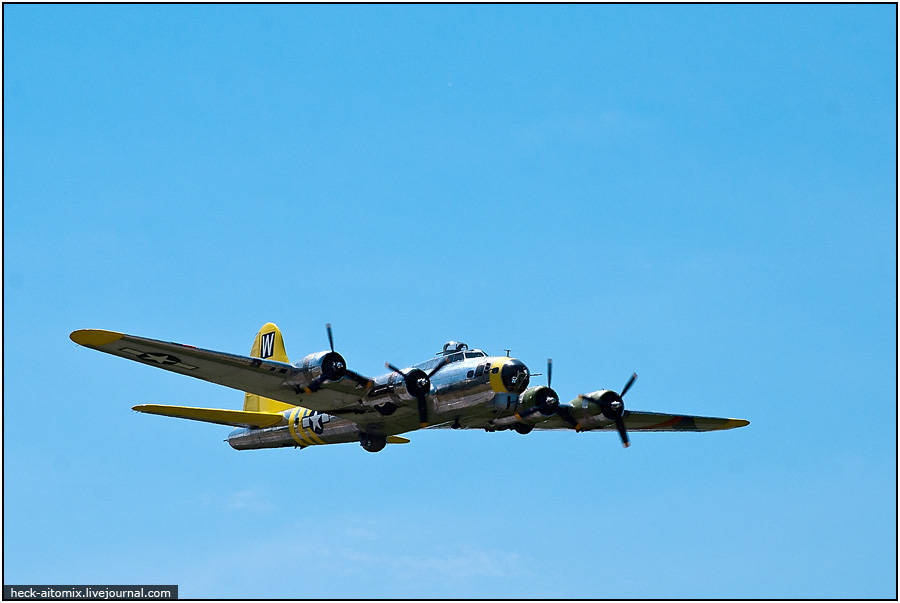
In Hamilton, viewers were shown two B-17s at once, both war veterans, one of whom participated in the legendary raid on Hamburg in 1943. On the night of 24, on 25, July, British forces, together with the Americans, launched Operation Gomorrah, which aimed to bomb the German port city of Hamburg. The operation lasted almost a week. Every night, over seven hundred (!!!) English bombers (Lancaster, Stirling, Halifax, Wellington) appeared in the sky over the city (or over what was left of it), covering the port with thousands of tons of bombs. And in the daytime, American aviation represented by several hundred Boeing B-17 Flying Fortresses went into action. The excessive confidence of the Americans in the invulnerability of the B-17, and the associated participation of these bombers in the daily attacks on Hamburg, did not justify itself. German fighters found the vulnerability of the Boeing - frontal attack. It was during the attack in the forehead that the Flying Fortresses experienced the greatest difficulties in defending their ranks and suffered serious losses. In the first days of operation for one flight could not return the order of 50-60 bombers.
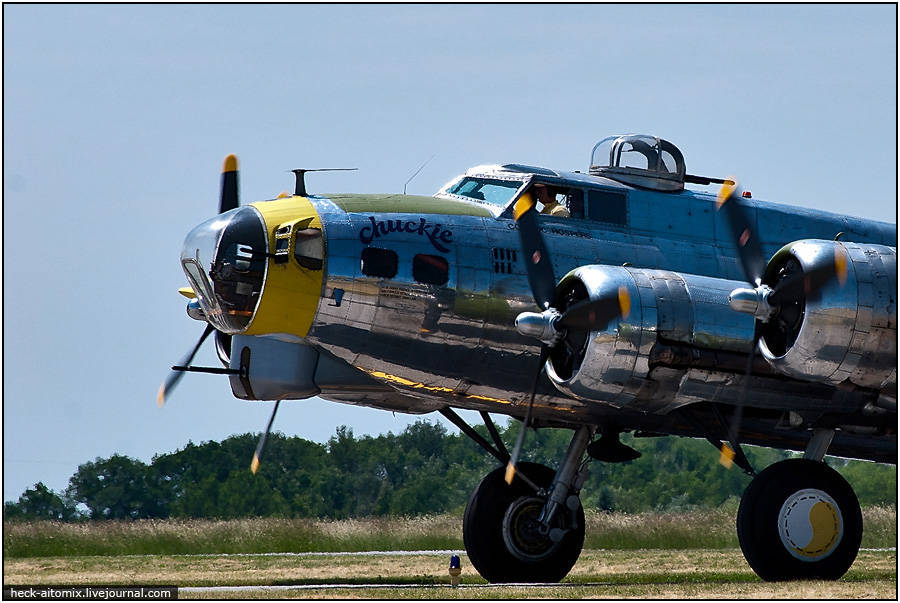
The serious losses of the bombers during the daytime raids forced the Americans to abandon this idea for a whole year. Only in the 1944 year with the advent of the Mustang P-51, which was immediately assigned to a support group. It was in such a bundle - Mustangs and Flying Fortresses - American aviation could once again feel invulnerable in aerial combat with the fascist invaders.
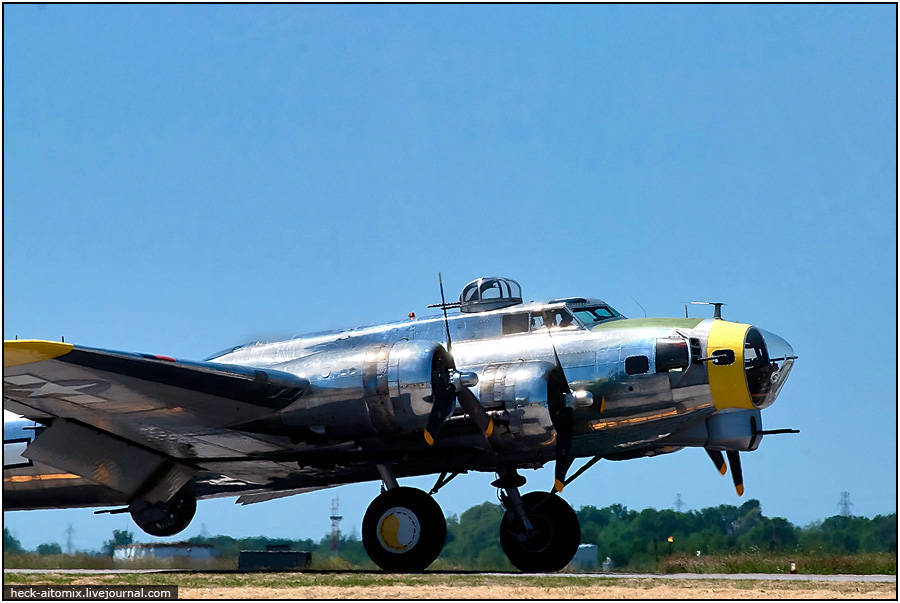
The B-17 bomber undoubtedly became one of the most important combatants in Europe during the Second World War. The well-known song "Comin 'In On A Wing And A Prayer" was dedicated to this machine, which was used by Chizh & Co.
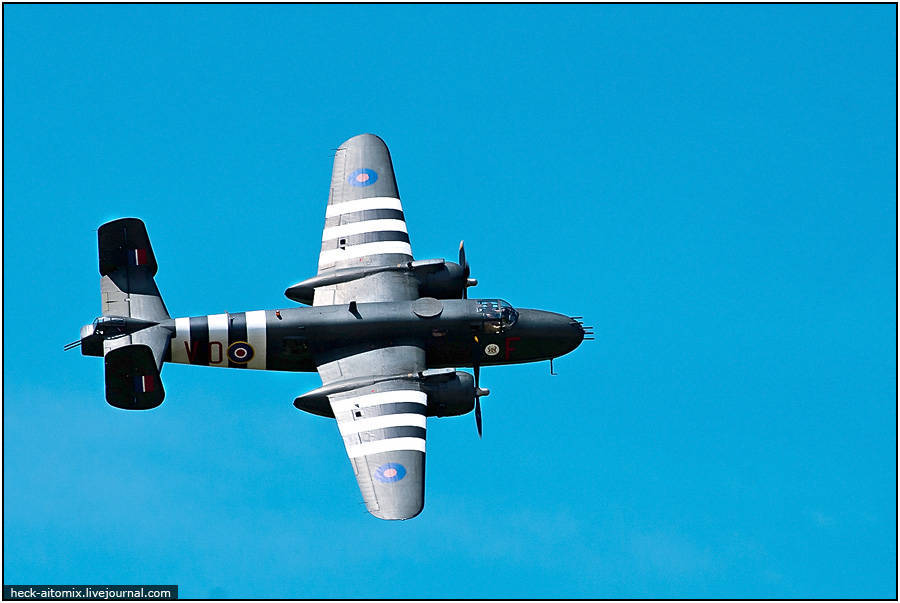
Of the not so heavy bombers, we managed to see the twin-engine North American B-25J Mitchell - the presented copy, although it was released at the beginning of 1945, didn’t get to war.
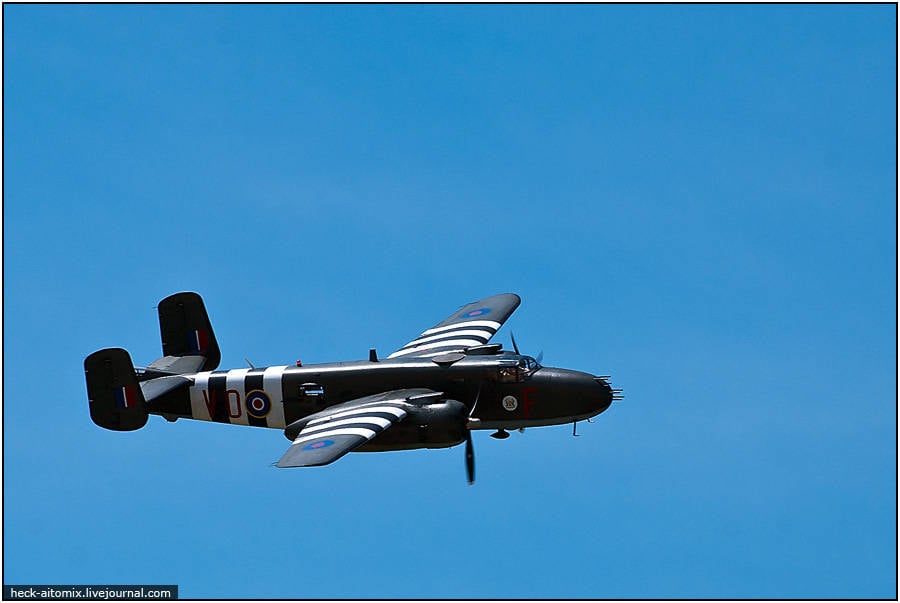
Very charismatic and photogenic striped bomber spent most of the time in the air over Hamilton. First, he participated in flights with fighters, then accompanied Lancaster and the Flying Fortresses. The pilot tried his best to please the audience, demonstrating now the left, then the right side of his car, greeted the audience by rocking the wings. By the way, in the movies, this type of aircraft is removed quite often. It could be examined in detail at Pearl Harbor, although military consultants criticized the creators for the historically incorrect use of these machines in the plot. An even more unrealistic use of the B-25 Mitchell can be found in Zek Snyder’s recently released screening Forbidden Reception (Sucker Punch), where this bomber successfully confronts a severe dragon in aerial combat.
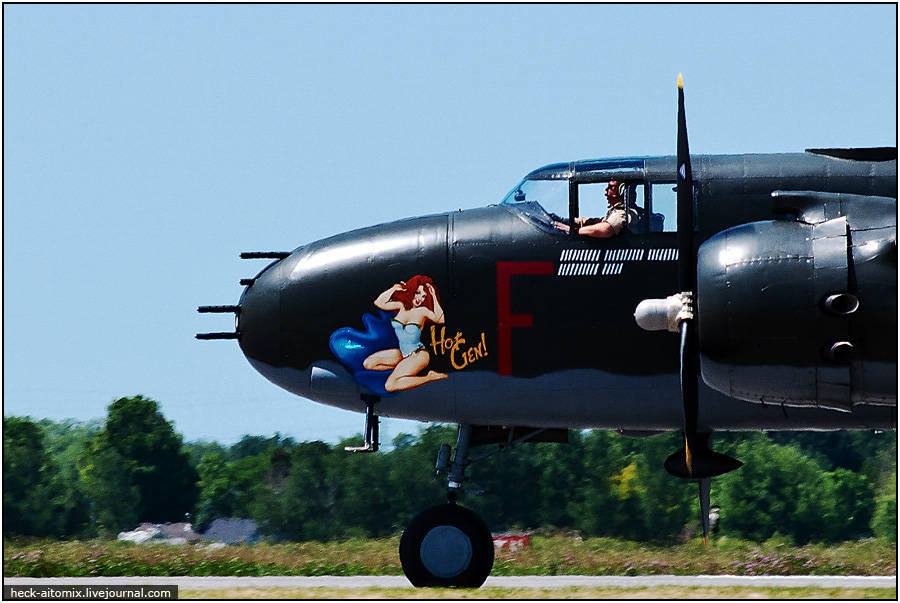
Each crew sought to decorate their fighting machine, to make it unique, recognizable. This copy of the Mitchell B-25 recreates the combat vehicle of the 98 squadron of the Royal British Air Force Hot Gen, which fought over northwestern Europe in the 1944-45's.
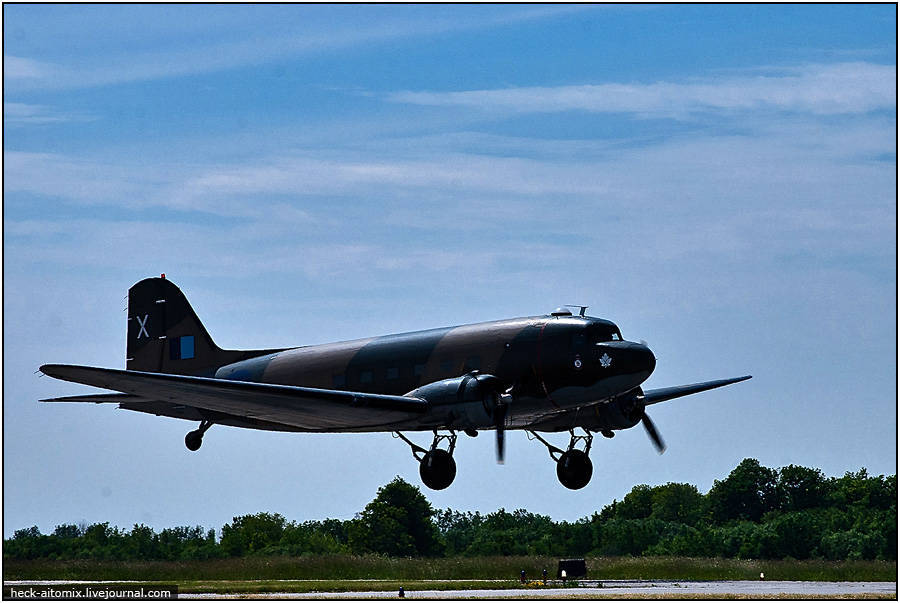
Auxiliary transport aviation, which supplied supplies of supplies and ammunition to regular troops and partisan detachments, conducted reconnaissance of the area, and dropped parachute assault forces, also made its significant contribution to the victory of the USSR and its allies over Nazi Germany. One of the most recognizable and massive transport aircraft was the American Douglas DC-3, or rather its military version of the Douglas C-47 Skytrain / Dacota.
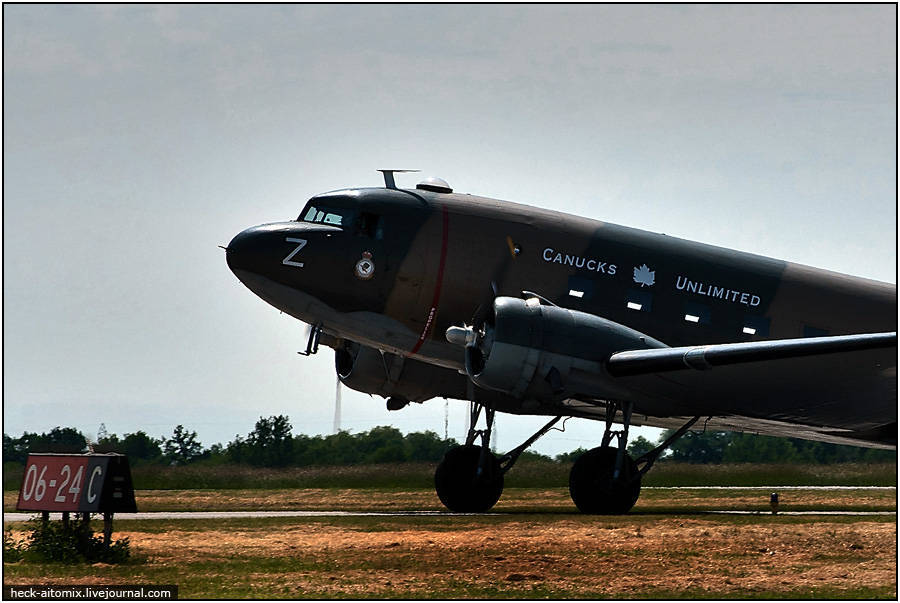
Since 1942, these machines were supplied to the USSR and made up a significant part of the transport fleet countries. The Dakota along with Li-2 were the backbone of our military transport aircraft. Although there were far fewer of them than the U-2 and P-5 (P-5), they carried out more than half of the transportation ... C-47s fly abroad now. These long-lived aircraft participated in almost all the wars that have occurred since then in the world. This reliable, durable and economical car has earned its truly legendary reputation.
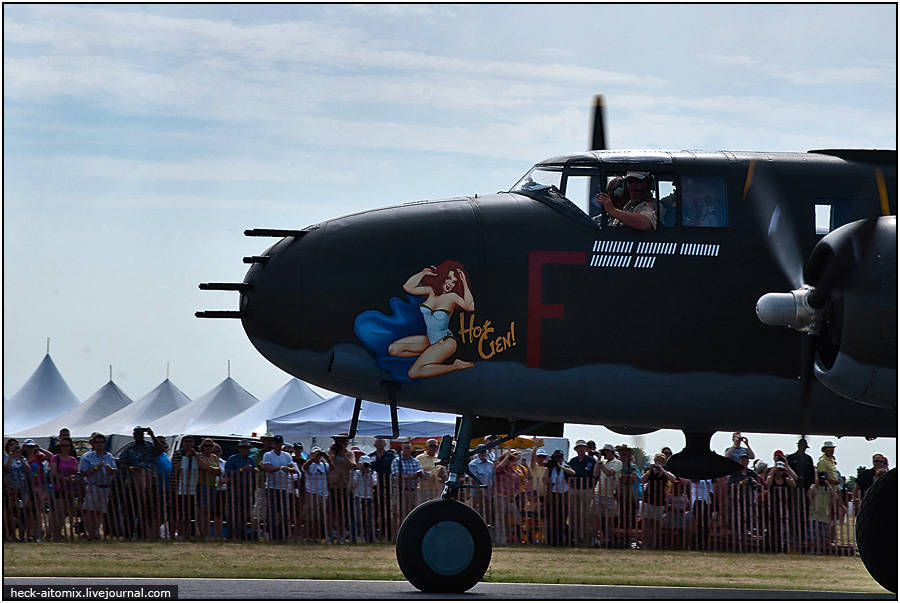
At this, the flight part of the air show imperceptibly ended, the pilots planted their cars to the applause of the audience, welcomed those present from their cabins. Here is the crew of the B-25J Mitchell Hot Gen on the steering track.
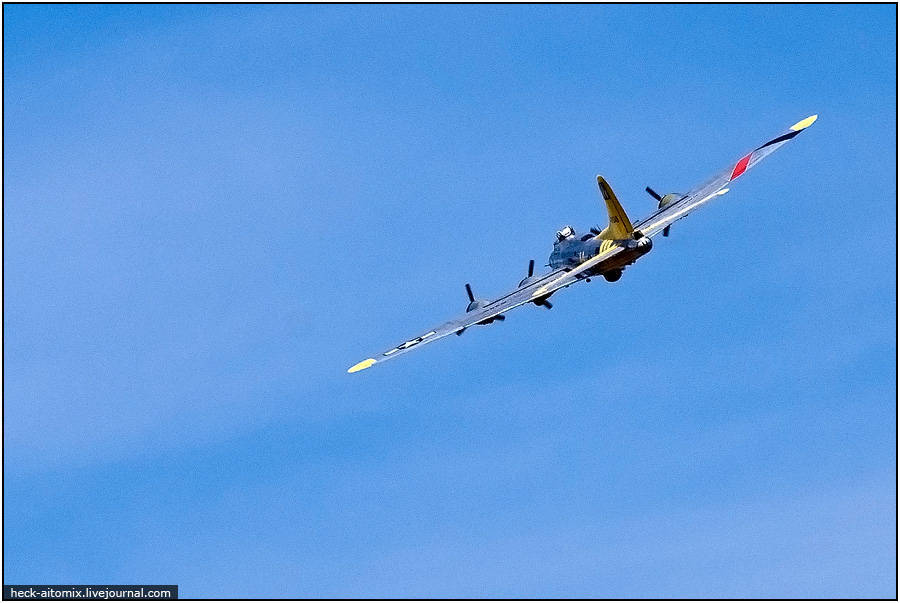
“Flying Fortress” Boeing B-17 shook its wings goodbye to the audience and is heading for its own airfield in Virginia Beach (Virginia, USA).
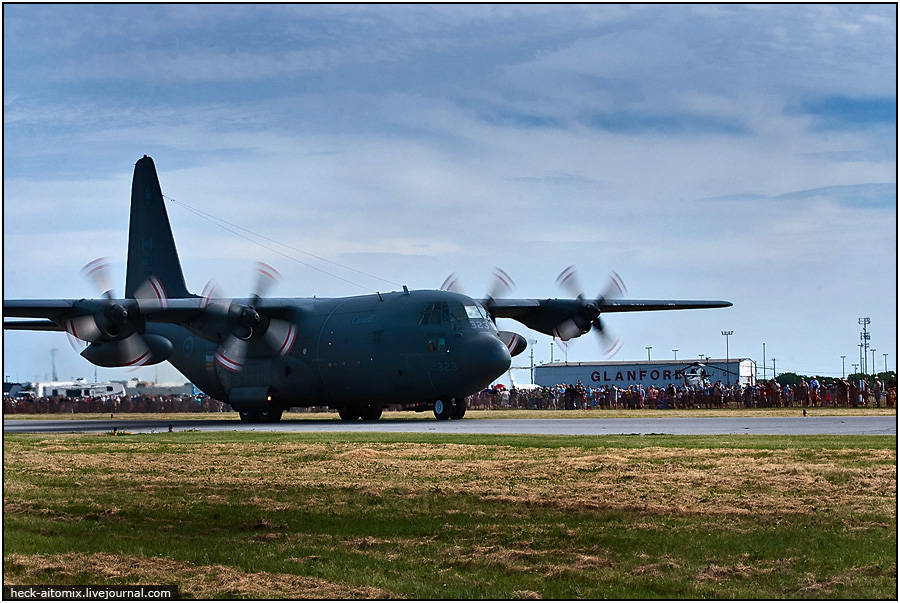
The spectators had not yet managed to disperse, as they had to freeze, as if rooted to the spot - a huge and very loud transporter C-130 Super Hercules was taxing out on GDP! A full-laid 130 infantryman or a paratrooper 92 can be placed in the C-64J cargo cabin. The aircraft can paratroop lightly in a light tank “Sheridan” (weight with platform - 19051 kg), as well as other weapons. The cargo is discharged through the cargo hatch in the rear fuselage, parachutists leave the plane through two doors in the right and left side (directly behind the landing gear compartments).
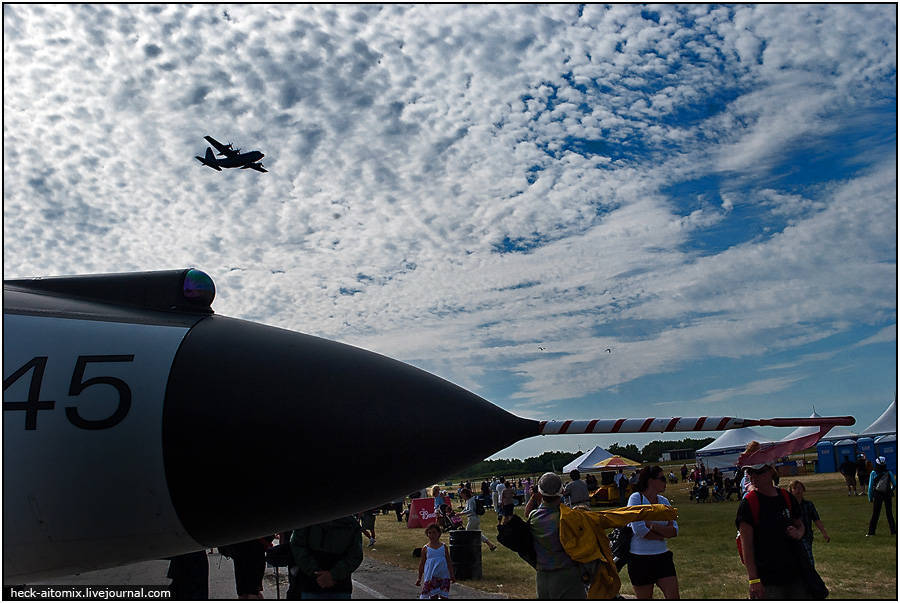
The Hamiltonian air show turned out to be so saturated and diverse, demonstrating to the public a multitude of samples of aviation technology from the beginning and middle of the 20 of the 20th century. Many of these aircraft survived the war, many were literally restored from photographs. In these proud, majestic machines, not only pride in their technique and a demonstration of historical superiority, in these machines lives the memory of those who fought and fought. The history of those times is too important and actually invaluable material, which should not be forgotten. I sincerely want to hope that our Soviet technology will not disappear into oblivion, the memory of the combatants will not be erased in memory. Alas, but the enthusiasm of individual lovers is not enough for this, and government support and interest is not very much observed.

The Hamilton 2011 Airshow of the Year is only a preparatory program for the next year's show, when the Canadian Aviation Museum of Heritage will be 40 years old. The organizers promise an even more exciting and unforgettable show. There is a red circle in my calendar. See you at 2012 in Hamilton, Ontario, Canada.
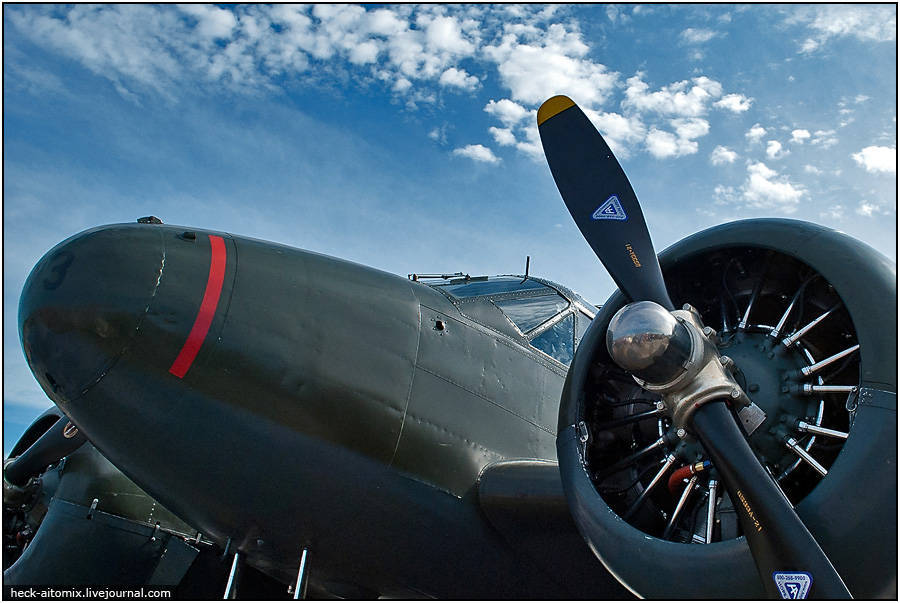
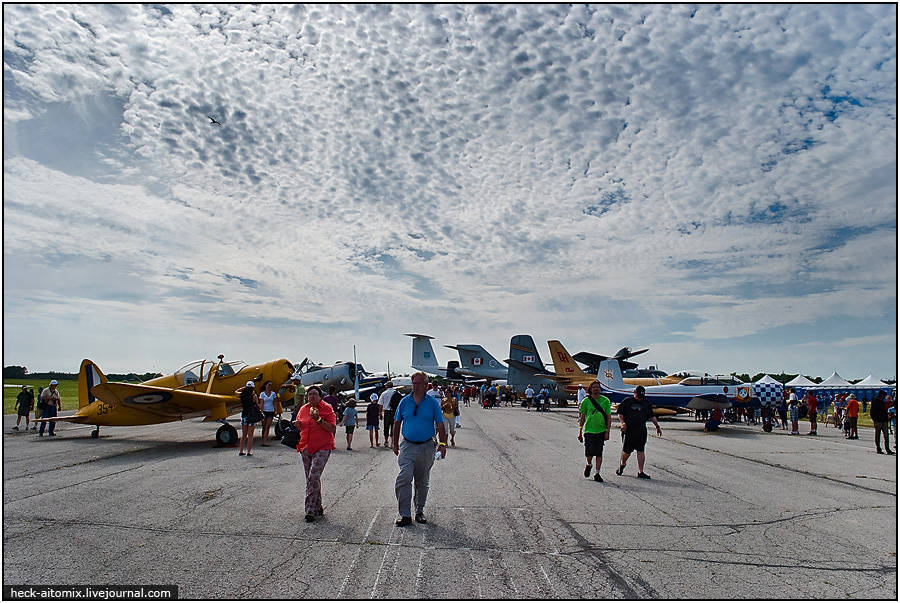
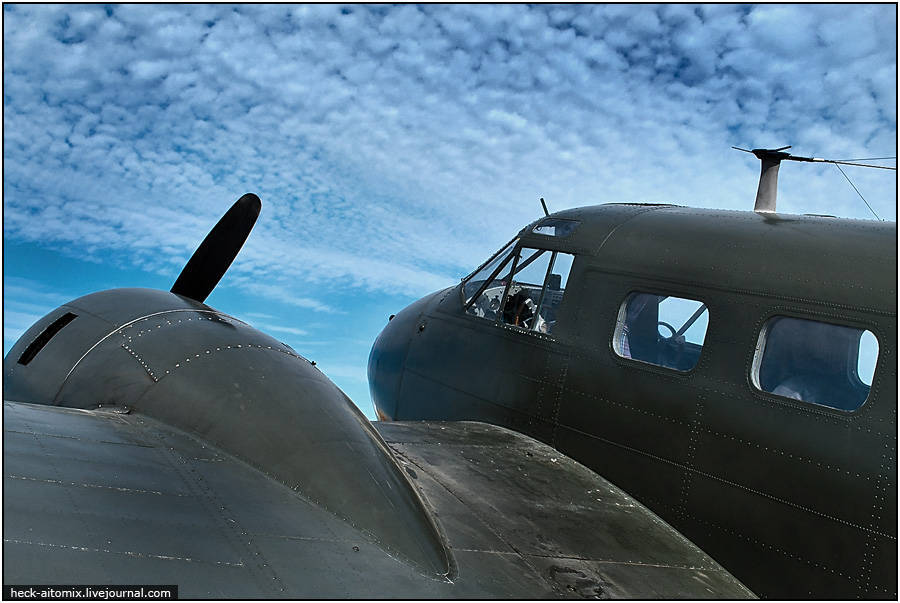
Information